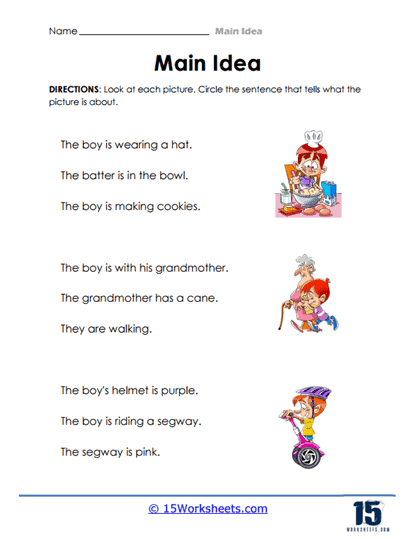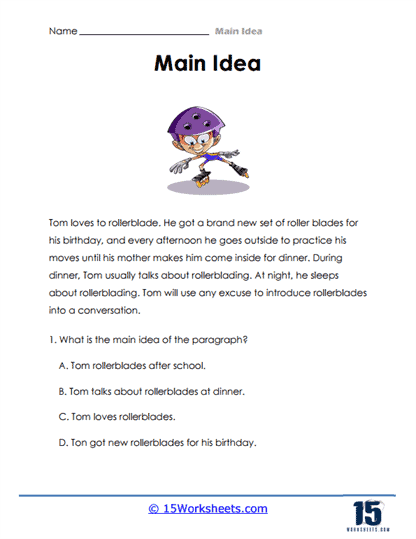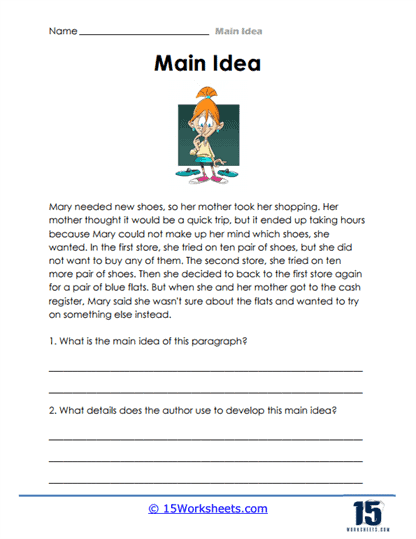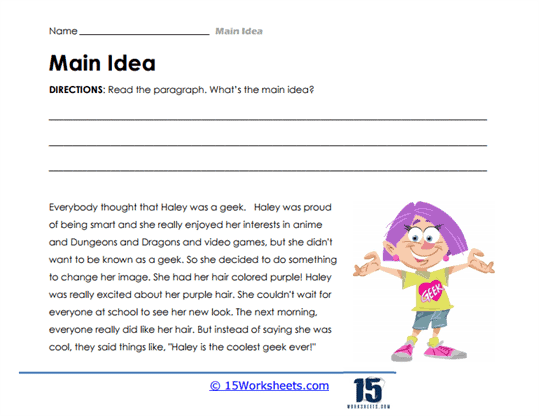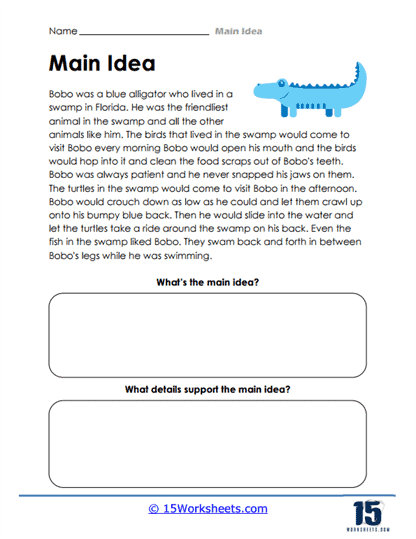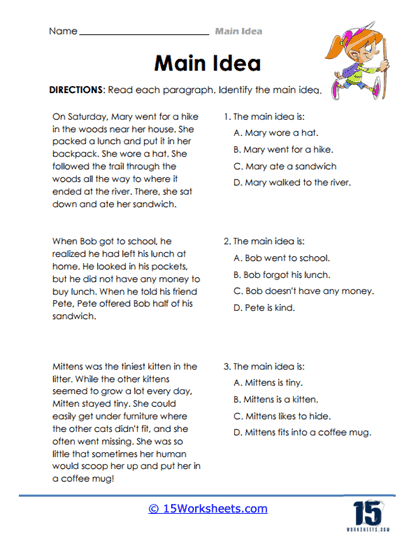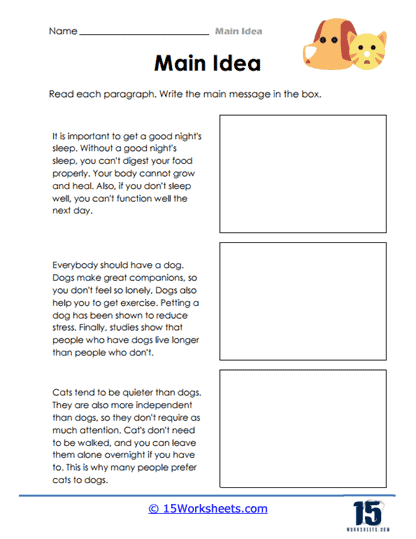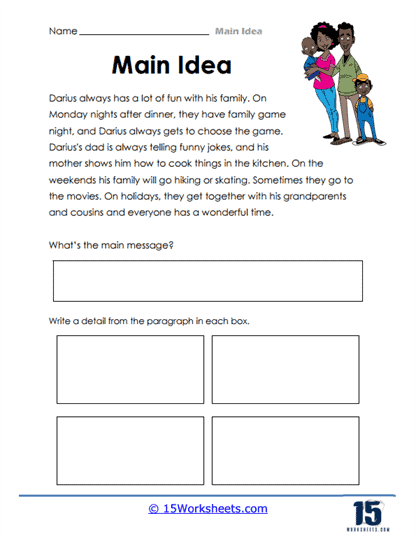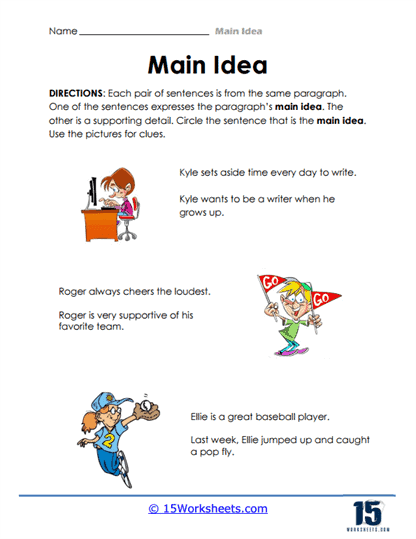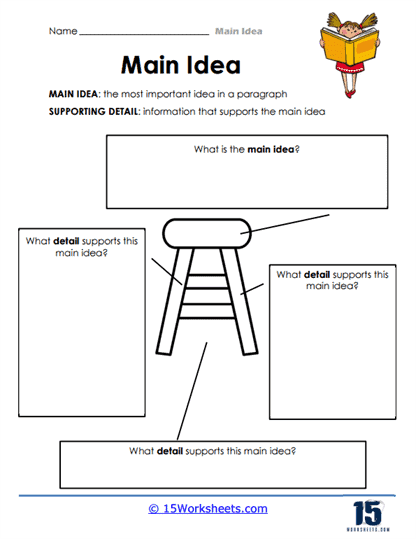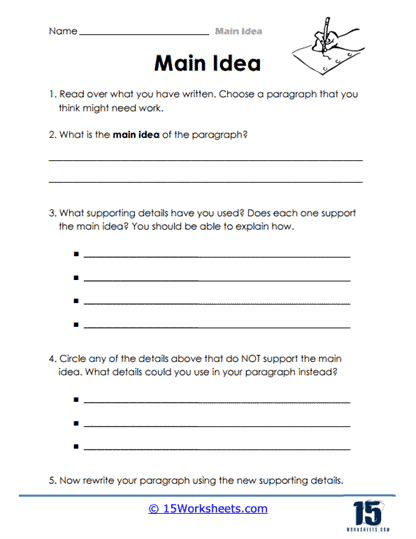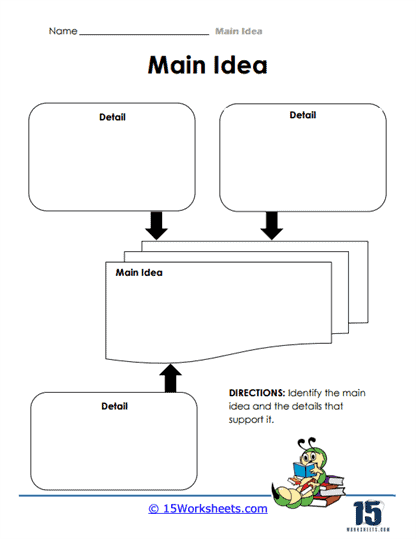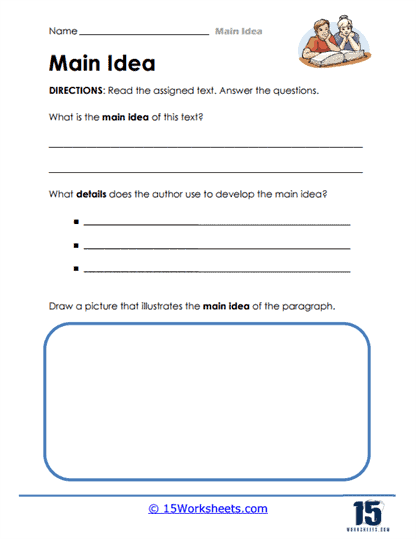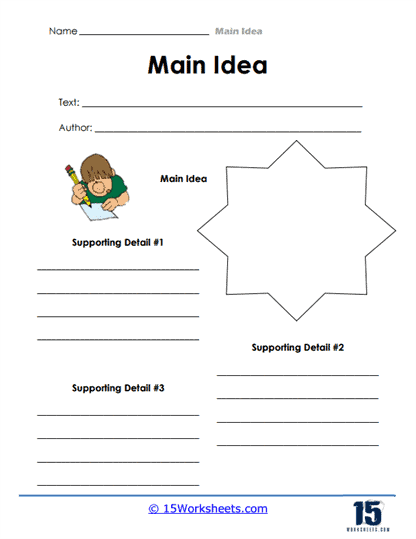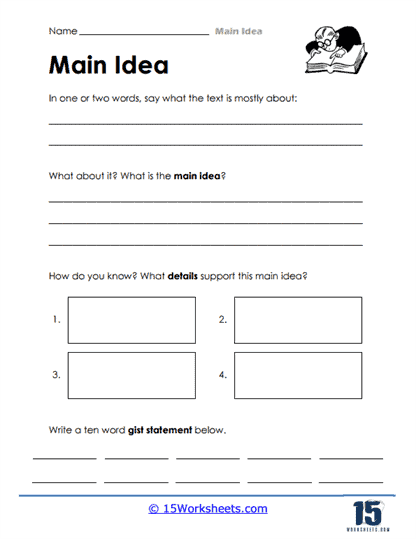Main Ideas Worksheets
All About These 15 Worksheets
The main idea of any text is the central point or the most important concept that the author wants to convey. It serves as the backbone of a passage, anchoring all other information around it. Whether it’s a short sentence, a detailed paragraph, or a lengthy article, the main idea is the thread that ties everything together, guiding the reader through the author’s thoughts and intentions. Understanding the main idea is crucial for developing strong reading comprehension skills, as it enables readers to grasp the overarching message of a text, rather than getting lost in the details.
Teaching the skill of identifying the main idea is a vital part of early literacy education. This collection of worksheets is specifically designed to teach and reinforce the concept of finding the main idea across various forms of text. These resources guide students progressively through different levels of reading comprehension, from the simplest of sentences to more complex passages. The exercises target essential reading skills, enabling students to identify not only the central message but also the supporting details that bolster that message.
Identifying the Main Idea from Pictures and Short Sentences
In the earliest stages of learning, students are often introduced to the concept of the main idea through visual aids. Some worksheets ask students to look at pictures and match them with short sentences that convey the main idea. This type of exercise builds a foundational skill-connecting visual cues with text. By pairing images with concise statements, young learners begin to understand how to extract the core meaning from a scene or description. This process helps them move from understanding individual pieces of information to recognizing how those pieces fit into a bigger picture. As they progress, they start applying these skills to written text without the need for visual support.
Paragraph Comprehension
As students advance, the worksheets introduce more complex tasks, such as identifying the main idea in a paragraph. This stage requires a deeper level of reading comprehension, as students must engage in close reading, analyzing not just the first sentence but the entire passage. This kind of exercise pushes students to go beyond surface-level understanding and to distill the central message from a mixture of facts, descriptions, or narrative details.
In this phase, students learn the importance of synthesis—the ability to bring together different pieces of information to form a complete understanding of what the text is trying to communicate. Summarizing a paragraph’s main idea becomes a skill that builds their capacity to think critically about what they’re reading and to focus on what truly matters.
The Role of Supporting Details
A significant portion of these worksheets also focuses on helping students identify supporting details-pieces of information that reinforce, explain, or expand upon the main idea. Supporting details are essential because they give depth to the central message. Without them, the main idea can feel shallow or unsupported.
In these exercises, students learn how authors structure their writing by weaving together the main idea with carefully chosen details. They are encouraged to distinguish between key pieces of evidence that support the main idea and other information that might be interesting but less relevant. This skill is particularly important when reading longer texts, where it’s easy to lose sight of the main point among a flood of information.
Comparing Main Ideas and Supporting Details
Another set of exercises presented in these worksheets helps students distinguish between the main idea and supporting details through comparison. By presenting two sentences—one that states the main idea and one that provides additional context—students can practice identifying the core message versus supplementary information. This process of comparison strengthens their ability to focus on what’s most important in a text and to avoid confusing minor details with the main point.
This skill is invaluable for developing clarity in comprehension. It helps students avoid being sidetracked by interesting but less critical facts, enabling them to stay focused on the central theme of what they are reading.
Encouraging Creative Analysis
The worksheets also include opportunities for creative analysis, where students are encouraged to summarize or explain the main idea in their own words. This aspect of the exercises is particularly beneficial because it tests not only their ability to comprehend the text but also their capacity to express that understanding clearly. When students rephrase the main idea, they are engaging in a deeper level of critical thinking. This reflective process allows them to articulate their interpretation and provides a chance for teachers to assess how well the student has grasped the concept.
Making Personal Connections to Engage Students
To make the reading material more relatable, some worksheets incorporate content that mirrors students’ everyday experiences, such as family interactions or common hobbies. This personal engagement allows students to connect the reading material with their own lives, making it easier for them to comprehend and retain the concepts. When students can see themselves in the text, they are more likely to invest in the learning process, increasing their motivation to dig deeper into the material.
Personal engagement doesn’t just make the reading more interesting; it also enhances comprehension. When students relate to the content, they are better equipped to analyze and reflect on the main idea and supporting details.
These worksheets are designed with variety in mind, catering to different learning styles and preferences. Some worksheets focus on simple identification of the main idea, while others present multiple-choice questions that challenge students to choose the best representation of the main idea from a set of options. Multiple-choice exercises test students’ ability to discern subtle differences between sentences and to select the most accurate one.
In contrast, other tasks require students to summarize the passage in their own words, helping them practice articulating the main idea concisely. This exercise strengthens their ability to distill complex information into clear and straightforward language, a valuable skill both in school and beyond.
Ultimately, these worksheets are crafted to enhance students’ overall reading comprehension skills. By systematically working through different types of texts and activities, students become more adept at identifying main ideas, recognizing supporting details, and understanding the various ways in which authors organize information. This structured approach helps students develop a strong foundation in reading, preparing them for more advanced comprehension tasks in the future.
What Are The Steps To Identifying The Main Idea?
Identifying the main idea in a passage is an essential skill that allows readers to grasp the core message of a text. Without the ability to determine the main idea, it becomes difficult to fully comprehend the author’s intent or the primary point being conveyed. This process is often broken down into several steps, each of which contributes to a clearer understanding of the text. Let’s take a closer look at each step in identifying the main idea, expanding on their importance and how they work together to enhance reading comprehension.
Step 1: Read the Entire Text
The first and most critical step in identifying the main idea is to read the entire text thoroughly. Skimming or jumping to conclusions without fully digesting the content can lead to misunderstandings or missing key details. When you read carefully, you begin to see the larger picture of what the author is trying to convey. This step helps set the stage for everything that follows, as it provides the necessary context to understand the structure and flow of the argument or narrative. At this stage, the goal is not to rush to judgment but to absorb the content, paying attention to the overall message. This initial reading gives you the foundation you need to analyze the text effectively.
Step 2: Look for the Topic Sentence
Once you have read the text, the next logical step is to locate the topic sentence. The topic sentence typically provides a clear indication of the paragraph’s or section’s main idea. In many cases, it’s found at the beginning of the paragraph, setting the tone for what follows. However, it can also appear in other positions, such as the middle or end, depending on the author’s style. The topic sentence serves as a beacon, pointing readers toward the central focus of the section. Recognizing it helps narrow down where the main idea resides, particularly in longer or more complex texts where the central message might not be immediately obvious.
Step 3: Identify Supporting Details
Supporting details are the building blocks that reinforce the main idea. They provide the evidence, examples, or explanations that make the central point more convincing. As you read, look for these details and notice how they relate back to the topic sentence. These could be statistics, anecdotes, facts, or specific examples that flesh out the primary argument. The main idea cannot stand alone without support; these details give it weight and credibility. By identifying these, you can better understand how the author builds their case and ensure that your interpretation of the main idea is grounded in the text.
Step 4: Determine the Recurring Information
An important strategy in identifying the main idea is to pay attention to recurring information or themes. When certain ideas or concepts are repeated throughout the text, they are likely to be significant. Repetition often signals that the author is emphasizing a point they consider crucial. This could come in the form of repeated words, phrases, or concepts that pop up in multiple paragraphs or sections. The more frequently something is mentioned, the more central it tends to be to the main idea. By focusing on this recurring information, you start to see patterns that reveal the text’s core message.
Step 5: Eliminate Irrelevant Information
As you gather information, it’s equally important to recognize what is irrelevant to the main idea. Not every detail in a passage is directly related to the central focus. Some information might serve as background context or be included for illustrative purposes but does not directly contribute to the main idea. Being able to filter out these distractions allows you to hone in on what truly matters. Irrelevant information might include tangents, side anecdotes, or extra commentary that, while interesting, does not enhance your understanding of the key message. By eliminating these unnecessary details, you create a clearer path toward identifying the main idea.
Step 6: Summarize the Main Idea
Once you have analyzed the topic sentence, supporting details, and recurring information, the next step is to synthesize this into a concise summary. Summarizing the main idea in your own words ensures that you have truly understood it. This step forces you to distill the text’s content down to its essence, leaving behind all the excess. When summarizing, ask yourself: “What is the author really trying to say?” This process also allows you to test your understanding-if you can explain the main idea succinctly, you’ve likely grasped the core message. A good summary captures the most significant points without adding unnecessary elaboration.
Step 7: Evaluate Coherence and Relevance
The final step in identifying the main idea involves evaluating how coherent and relevant the supporting details are in relation to the main point. At this stage, you want to assess whether the supporting details and the main idea align seamlessly. Does everything you’ve read connect back to a single overarching concept? Is the main idea truly the most significant point being conveyed, or is there another layer of meaning that hasn’t been uncovered? This evaluation process ensures that the main idea is not only clear but that it also encapsulates the full scope of the text. If the main idea logically ties together all the elements of the passage, you know you’ve identified it correctly.

